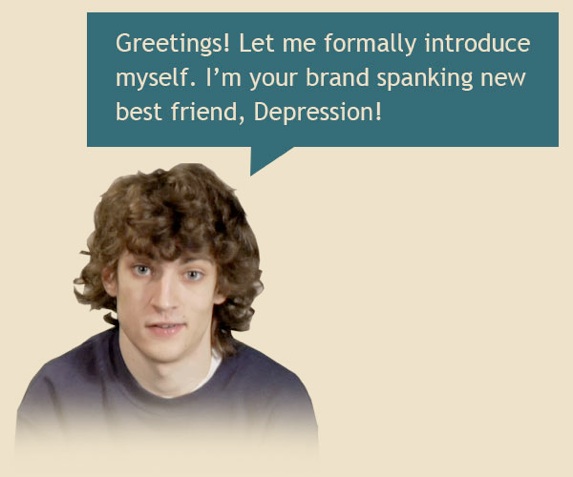Latest Public Service Radio Minute
Loss of EmploymentLoss of Employment, MP3, 1.3MB
Listen to or download all our PSAsSupport Our Work
Please donate so we can continue our work to reduce the stigma of psychiatric illness, encourage research, and support educational activities for behavioral health professionals and the public. Ways you can donate and help are on our Support and Donations page. Thank you!
More InfoLatest News Around the Web
Older Adults With Higher Levels Of Loneliness May Be At Increased Risk For More Severe Depression Symptoms, Study Indicates
Healio (11/20, Gramigna) reported, “Older adults with higher levels of loneliness were at increased risk for more severe depression symptoms,” investigators concluded after “analyzing seven waves of data collected once every two years between 2004 and 2017 of adults aged 50 years and older who were included in the English Longitudinal Study of Ageing.” The findings of the 4,211-participant, “population-based cohort study” were published online Nov. 9 in The Lancet Psychiatry.
Related Links:
— “Reducing loneliness among older adults may prevent future depressive symptoms “Joe Gramigna, Healio, November 20, 2020
Severe Emotional Distress, Anxiety Tied To Major Disasters May Lead To Suicide, Researchers Say
HealthDay (11/20, Murez) reported research indicates that “severe emotional distress and anxiety for those who have lived through major disasters can…lead to suicide.” Investigators arrived at that conclusion after examining data on “281 natural disasters during a 12-year period and their impact on suicide rates in those communities.” The study revealed that “suicide rates increased by 23% when compared to rates before and after the disaster.” The findings were published online Oct. 9 in the Journal of Crisis Intervention and Suicide Prevention.
Related Links:
— “Disasters Leave a Rise in Suicides in Their Wake: Study ” Cara Murez, HealthDay, November 20, 2020
Number Of Women Contemplating Suicide Or Self-Harm During Or After Pregnancy May Be Rising, Study Indicates
HealthDay (11/20, Norton) reported, “The number of women who contemplate suicide or self-harm during or after pregnancy may be on the rise,” investigators concluded in a study revealing that “among nearly 600,000 U.S. childbearing women, researchers found that close to 2,700 were diagnosed with suicidality in the year before or after giving birth.” The findings were published online Nov. 18 in JAMA Psychiatry.
According to Psychiatric News (11/20), the study “authors noted that Black women, those with lower incomes, and younger women experienced the larger increases in suicidality.” They wrote, “Given the severe maternal mortality crisis among racial/ethnic minority individuals, especially Black women, it is imperative to include psychiatric risks in predictive models and practice guidelines.”
Related Links:
— “Suicidality Among Childbearing Women Found to Increase Over 12-Year Period, Psychiatric News, November 20, 2020
Patients With SARS-CoV-2 May Present With Only Symptoms Of Delirium, Study Indicates
Modern Healthcare (11/19, Castellucci, Subscription Publication) reports researchers found “patients with coronavirus – particularly those over 65 – may present to healthcare settings with only symptoms of delirium rather than well-known signs of the virus like fever and shortness of breath.” The findings were published in JAMA Network Open.
STAT (11/19, Cooney) reports that in the study, “more than one-fourth of older patients…arrived at hospital emergency rooms with delirium, and 37% of these patients had no typical Covid-19 signs, such as fever or shortness or breath.”
Psychiatric News (11/19). also covers the story.
Related Links:
— “Modern Healthcare Requires Subscription
CDC Urges Americans To Stay At Home For Thanksgiving As Virus Cases Surge Across US
The Washington Post (11/19, A1, Shammas) reports, “With Thanksgiving a week away and coronavirus cases exploding nationwide, the Centers for Disease Control and Prevention on Thursday recommended against traveling or gathering for the holiday, urging Americans to consider celebrating in their own households instead.” In the agency’s “first news briefing in months, officials said they were alarmed to see 1 million new cases reported across the United States within the past week.” As the nation’s death toll “since the start of the pandemic reached 250,000, officials spoke of the risks in stark terms, warning that as friends and relatives get together over the holidays, they could inadvertently bring the coronavirus with them.”
Related Links:
— “CDC recommends against Thanksgiving travel amid surge of coronavirus cases “Brittany Shammas, The Washington Post, November 19, 2020
Foundation News
Nothing Found
It seems we can’t find what you’re looking for. Perhaps searching can help.

